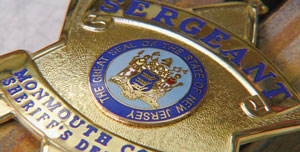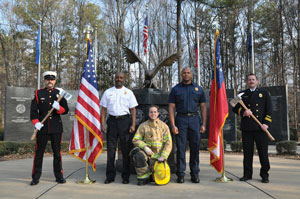[one_half][dropcap style=”font-size: 60px; color: #26738c;”]T[/dropcap]he story of badge manufacturer Smith & Warren is a story of the successful transition of a multi-generational business over the course of two decades. It is a testament to the power of holding fast to sound business principles as well as family values. Smith & Warren is a shining star in the badge industry and its story is a reminder that, even in tough economic times, a company can still succeed by putting customers first.
Despite decreased funding and tighter budgets for public safety, badge manufacturer Smith & Warren manages to grow each year – 17 percent in the past two years alone. Despite fierce competition from companies that take their manufacturing overseas, Smith & Warren has remained dedicated to manufacturing its products in the United States, which has earned loyal customers who value quality, delivery and attentive service. The company also has managed to run smoothly since 1990 through major structural and technological transitions. And the family behind the company has found a way to work together perfectly, allowing the company and its customers to benefit from each family member’s strengths and talents.
Smith & Warren was founded in 1925, and over the course of about 60 years, the company changed hands a number of times. In 1990, Smith & Warren was up for grabs again. It was advertised for sale in the business opportunity section of the New York Times, and the ad caught the eye of New York entrepreneur Julian Galperin. At the time, Julian and his wife, Helena, were working as subcontractors, operating an electroplating business in White Plains, N.Y. By contributing to a finished product, they had learned a great deal, and they were ready for the next step. They knew that they would find long-term success in manufacturing and creating a brand, and purchasing Smith & Warren seemed to be the perfect way to reach those goals. Julian and Helena took a chance on purchasing the company, and business was good.
Between 1990 and 1999, the couple grew the company slowly and steadily. During that time, they developed Smith & Warren’s first color catalog, and they regularly attended trade shows, gradually building a national network of dealers. They acquired badge and military manufacturer EKS Apollo and built in-house capabilities to complete all manufacturing processes.
Julian and Helena made a good team. Julian, a professional engineer, oversaw all aspects of the badge manufacturing. He added stamping, computerized engraving, soldering and enameling processes to the existing plating and polishing operations. He also brought relentless energy, creativity and an entrepreneurial spirit to the table. He came up with new ideas, which he was quick to implement. His motto, which he picked up from a business journal, was “Better sooner than perfect,” and this attitude encouraged forward movement at Smith & Warren. Helena managed sales and administration for Smith & Warren, and she balanced Julian’s creativity with her attention to detail and cautious nature. She kept a close eye on the books and concerned herself with the company’s stability.
The Galperin children, Lee and Stephanie, didn’t anticipate working for Smith & Warren given the company’s size. “There was no room. It just wasn’t in the cards,” Lee says. They each pursued their own interests. Lee earned a degree in accounting and finance in 1997, went to work for world-renowned accounting firm Arthur Andersen, and received his CPA license. Stephanie earned a Bachelor of Arts degree in executive administration and event planning in 1999 and went to work for a real estate management firm in New York City.
In 1999, badge and insignia manufacturer Everson Ross approached Julian and Helena with an offer to sell them the company. As they had before, the couple seized the opportunity. Suddenly, they had a much larger company on their hands, so they recruited the help of their children. Lee joined the company in 2000 and Stephanie in 2001. They both started out on the production floor and learned the business from the inside out.
By 2003, Lee had become involved in many areas of the company, including production management, sales and marketing. Stephanie utilized her strengths in administration, eventually taking over and improving many of the administrative processes at the company, including human resources and personnel development.
As Julian and Helena had complemented each other’s strengths before, Lee and Stephanie brought their own strengths to the company, and now each member of the family was contributing in their own unique way.
Smith & Warren was growing steadily, and at every step along the way, the company was improving its products and services. “In the early 1990s, our quality wasn’t quite as good as it is now, and our line was not as broad,” says Lee. “But we were lucky to have customers who really believed in us and wanted us to succeed. They gave us feedback, and we acted on that feedback. We had a lot of respect for our customers, and we wanted to do the best we could for them.”
Customers wanted durability, quick turnaround times and attentive service. The company responded by investing in advanced metal finishing and manufacturing technologies to make the product more durable and to cut down on lead times. Smith & Warren also implemented technologies to improve the customer buying experience and to help dealers’ businesses run more smoothly. One such technology was the VisualBadge interface on the company’s website, which Lee says “revolutionized how dealers communicated with Smith & Warren.”
Smith & Warren’s dedication to quality and technology didn’t go unnoticed. In 2009, producers of the Science Channel’s hit show “How It’s Made” approached Smith & Warren, asking if they could tour the company’s facility. The producers liked the fact that Smith & Warren manufactured its own products, they appreciated the company’s use of technology, and they recognized the quality of Smith & Warren badges. The crew was able to film the segment in one day, and Smith & Warren was featured in a portion of the “How It’s Made” police badges episode.
Seeing the Smith & Warren badges being manufactured is truly remarkable. Some of the work is done by incredibly powerful machines, but much of the work is still done by hand, and the individual attention and care that each badge receives is significant.
In that way, the creation of Smith & Warren badges is strikingly similar to the way the members of the Galperin family came together to form the company. Each person assumed his or her respective role in the company, much like the individual machines that have their specialized use.
Together, they work like a well-oiled machine. Their success was part precise calculations, part chance and luck, and part good, old-fashioned hard work. And the driving force behind it all has been their complete dedication to customer satisfaction. As Lee says, “It’s easy to grow your company when you give your customers what they want.”
Attitude has been the other major key to Smith & Warren’s success, especially in recent years. Despite reduced funding for public safety and tight budgets, Smith & Warren has grown 17 percent in the past two years. Lee says that the company never got discouraged by the economic situation. They simply worked harder. They also have remained dedicated to manufacturing their badges in the United States at a time when there is fierce competition from companies that take their manufacturing overseas. Lee says that customers still value the quality and customization that Smith & Warren offers, and he hopes that their desire for quality will continue to outweigh the appeal of cheaper products.
In 2009, Lee and Stephanie became officers at Smith & Warren. Julian and Helena still maintain daily involvement at the company and don’t anticipate ever retiring completely. Yet it’s clear that the new generation has put its stamp on the company. Along with their staff, Lee and Stephanie are the new face of Smith & Warren. Lee hopes that someday, a third generation of Galperins will join the company. His advice for them? “Put in 120 percent every day and enjoy your time in the trenches. To succeed, you must love what you do. Ultimately, customers sense and share your excitement. If customers know that you care about their needs, you’ll be rewarded with increased business.”
Smith & Warren
127 Oakley Ave.
White Plains, NY 10601
(914) 948-4619
www.smithwarren.com
[email protected]![]()
[/one_half]
[one_half_last]



[testimonial company=”Smith & Warren” author=”Lee Galperin”]
In the early 1990s, our quality wasn’t quite as good as it is now, and our line was not as broad. But we were lucky to have customers who really believed in us and wanted us to succeed. They gave us feedback, and we acted on that feedback. We had a lot of respect for our customers, and we wanted to do the best we could for them.
[/testimonial]






[/one_half_last]













